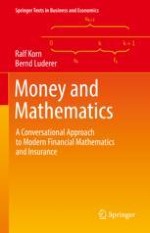This book follows a conversational approach in five dozen stories that provide an insight into the colorful world of financial mathematics and financial markets in a relaxed, accessible and entertaining form. The authors present various topics such as returns, real interest rates, present values, arbitrage, replication, options, swaps, the Black-Scholes formula and many more. The readers will learn how to discover, analyze, and deal with the many financial mathematical decisions the daily routine constantly demands.
The book covers a wide field in terms of scope and thematic diversity. Numerous stories are inspired by the fields of deterministic financial mathematics, option valuation, portfolio optimization and actuarial mathematics. The book also contains a collection of basic concepts and formulas of financial mathematics and of probability theory. Thus, also readers new to the subject will be provided with all the necessary information to verify the calculations.
